8.23 America’s Earliest Part II
Latest Update: 2025 Feb 20
Originally posted: 2024 Jan 31
According to Florian Cajori in his 1909 treatise,93 the earliest slide rule made and distributed in America appeared to be the circular slide rule of Palmer, c. 1843, which is described in the vignette America’s Earliest Slide Rule. As we know, Keuffel and Esser began their slide rule manufacturing in the U.S. in the mid-1890s, followed by the likes of Dietzgen and Richardson in the early 1900s, Gilson by the mid-1910s, and on it went. So it seemed easy to accept that the Palmer’s scale, for sale over 50 years earlier, was likely the first. Or was it?
Even Cajori left open the possibility that there could have been earlier American-made slide rules, claiming that the Palmer scale was “one of the first, if not the first, slide rule” made in the U.S.94 So what, if any, slide rules – Carpenter’s rules, for instance – were perhaps being made earlier in America? In an interesting article found in the Journal of the Oughtred Society,95 Thomas Wyman discusses the early Gunter’s rules, Carpenter’s rules, and Engineer’s rules that were being made in the early part of U.S. history. A number of boxwood rule makers were formed, mostly in Connecticut, in the mid-1800s. The famous Stanley Rule & Level Company is a good example. And Wyman discusses a Carpenter’s rule that was made by Clark & Co., of Vermont, c. 1835 or so. But, as he points out, the earliest known company of this kind was formed in 1821, by Thomas Belcher of New York. And the Belcher company was known to have made Gunter’s rules and other rules with Gunter scales.
8.23.1 An Early Belcher Slide Rule
The Oughtred Society lists its “Rarities” in which a couple of Gunter scales are shown that were made by Belcher Brothers & Co. A cursory look at some of the major slide rule collectors as well as the ISRM shows that Belcher-made slide rules and Gunter scales are fairly rare. So I was both surprised and elated to find recently a Belcher-made slide rule for sale online.
The rule was being sold out of California. And it was not just a standard ruler, not a Gunter’s rule and not a Carpenter’s rule; rather, it was an Engineer’s rule. That is, it has scales that could be called A, B, C, and D, where the first three are two-decade long scales labeled from 1 to 10 to 100, while the fourth scale is a single decade from 1 to 10. The B and C scales are on the slide.
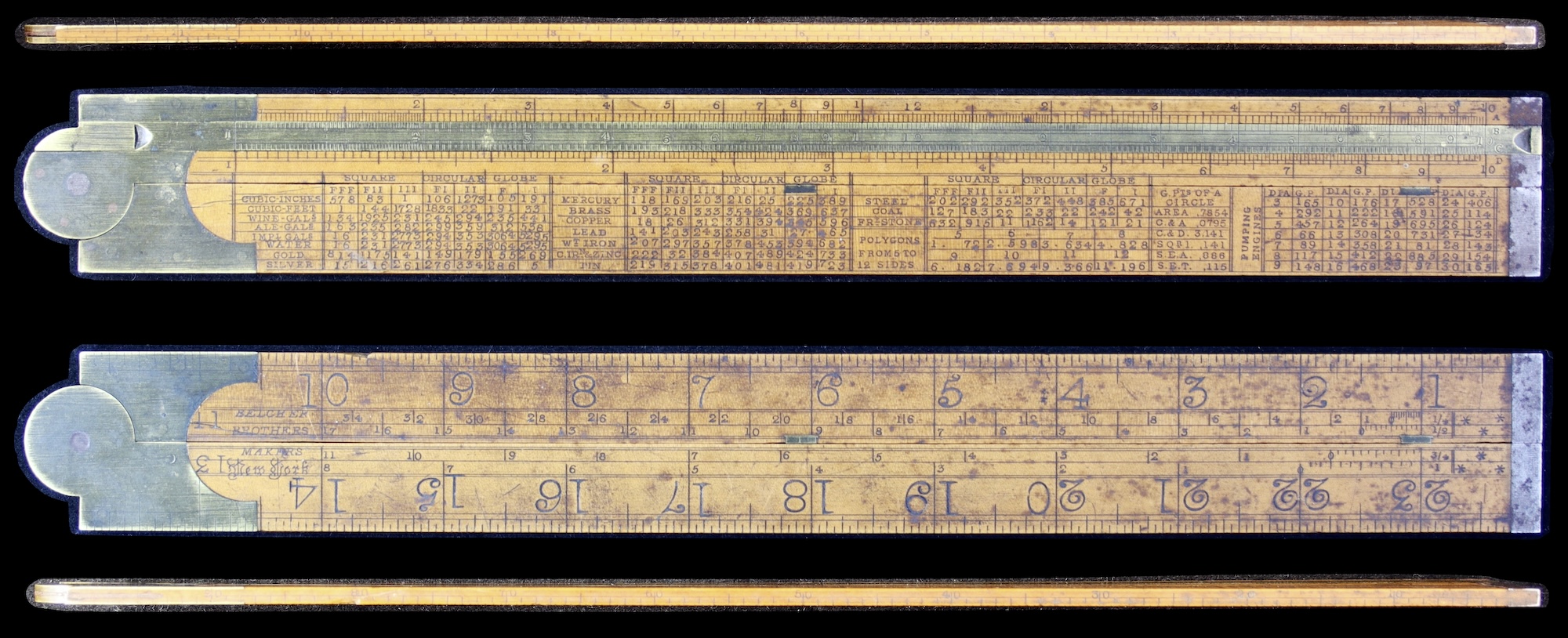
As can be seen, in addition to the Gunter’s scales there is a table of Gauge Marks on the front for use in a variety of calculations, including for pumping engines. On the back are linear scales, the major one being from 0 to 24 inches when unfolded, in 16-ths of an inch, and other shorter scales in units of 1/4-inch, 1/2-inch, 3/4-inch, and 1-inch. There are also scales along the outside edges of the rule. Along the top edge are two scales, each from 0 to 12 inches, but the top one marked in units of 1/10-inch while the bottom one is in units of 1/12-inch. Along the bottom edge is a single scale from 0 to 100, i.e. marked in units of 1/100-foot.
The Maker’s logo shows that this Engineer’s two-fold boxwood slide rule with brass slide was from the period 1831-1843; and the script-style of the words “New York” suggests it was rather early in that period. Thus it is apparent that this slide rule is earlier than the Palmer’s Computing Scale of 1843.
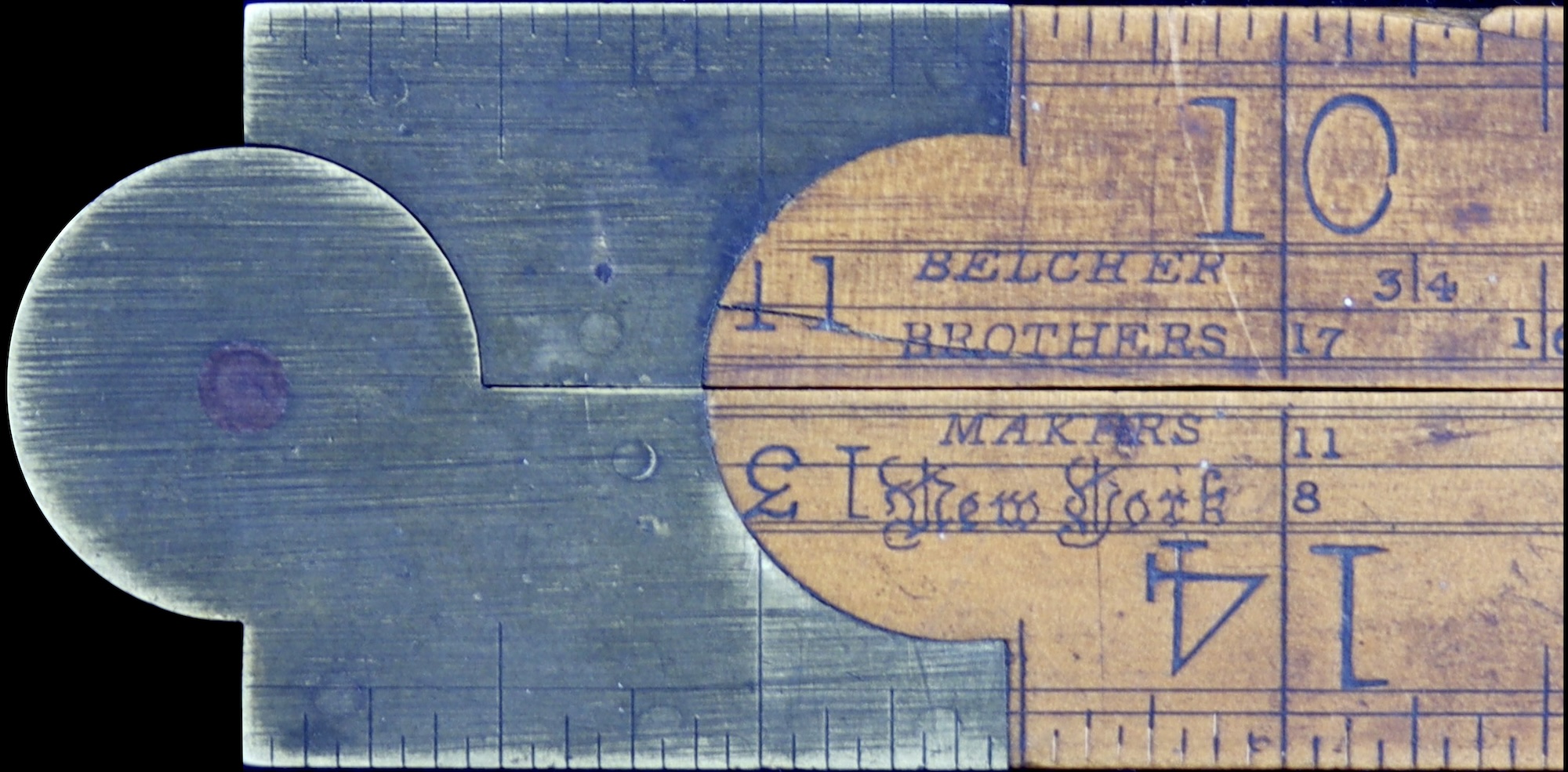
8.23.2 Notes on the Brothers Belcher
According to family records,96 the Belcher bloodline can be traced back as far as about 1066, when their ancestors landed in England from Normandy. But let’s move forward to a time at which slide rules were being produced. John Belcher (1719-1785) was born in London to William Belcher, a brewer’s clerk, and Martha Jones. John is recorded living in Birmingham, England, and being married to Sarah Richards in 1760. The couple later relocate to Sheffield, South Yorkshire, where John begins a rule making business. In 1797 John’s son, Zachariah, at the age of 32, is listed as a “rule maker, Purchase Knife maker” in Sheffield, evidently taking up a role in the family business.
Zachariah Belcher married Martha Harborne in 1793. The couple had six sons, five of whom eventually immigrated to the U.S. in the 1820s and 1830s. The oldest three, Thomas, William, and Charles, all immigrated in 1824. Evidently independent round-trips from England occurred earlier than this, as Thomas Belcher was listed in the 1822 New York Directory as “rule maker” at 145 Division Street, when he was 25 years old. Interestingly though, according to the family records, it was apparently William who made a round trip from England to New York in 1821, at age 22, perhaps scoping out the city and registering the family for a future business. In 1824 all three brothers immigrated to the U.S., bringing equipment and inventory from England to be used in the rule-making business.
So officially, Thomas was a “solo” American rule maker from about 1821 and was soon joined by brother William to form the company T. & W. Belcher sometime between 1822-1824. And thus was the apparent start of the production of quality boxwood rules in the U.S., a business that includes Gunter scales and slide rules. The company name was changed in 1831 to Belcher Brothers when brother Charles joined the effort. Note that a Gunter’s scale or Carpenter’s/Engineer’s rule marked T. & W. Belcher would have been made between 1824 and 1831, and would be older than the known Clark & Co. slide rule from 1835 that was noted earlier in our story.
Over the next 12 years, from 1831 to 1843, the company marked its rules in the following ways:97
- BELCHER BROTHERS MAKERS / NEW YORK
- BELCHER / BROTHERS/ MAKERS / NEW YORK
- * BELCHER BROTHERS MAKERS * / * NEW YORK *
- BELCHER BROTHERS MAKERS NEW YORK
where a “/” denotes a new line for the text that follows it. Our Belcher Brothers rule shown in the above image was made during this period, and bears the second style mark of the list above, with “New York” in a stylish script.
In about 1843 the company moved its manufacturing facilities to New Jersey (though they still had their main offices in New York), and changed the name to Belcher & Brothers, at least for the New Jersey part of the business. By 1853 the entire operation went by the name Belcher Bros. & Co.
Lufkin Rule Company, a popular rule maker that was established in 1869 in Cleveland, OH, but was soon moved to Saginaw, MI, bought the Belcher Brothers company on March 9, 1907. Lufkin was sold to Cooper Industries in 1967, which was later acquired by the Eaton Corporation in 2012.
While five sons immigrated to the U.S., Zachariah and his first-born son, John, remained in England, as well as five daughters. Various descendants of this John Belcher, including an occasional “Zachariah”, continued the original business in England. A 1911 directory shows a “Harold William Belcher (Zachariah Belcher & Sons) Rule Manufacturer” in Sheffield, when Harold was 27 years old. He was quite likely the last to run the England-based Belcher rule business.
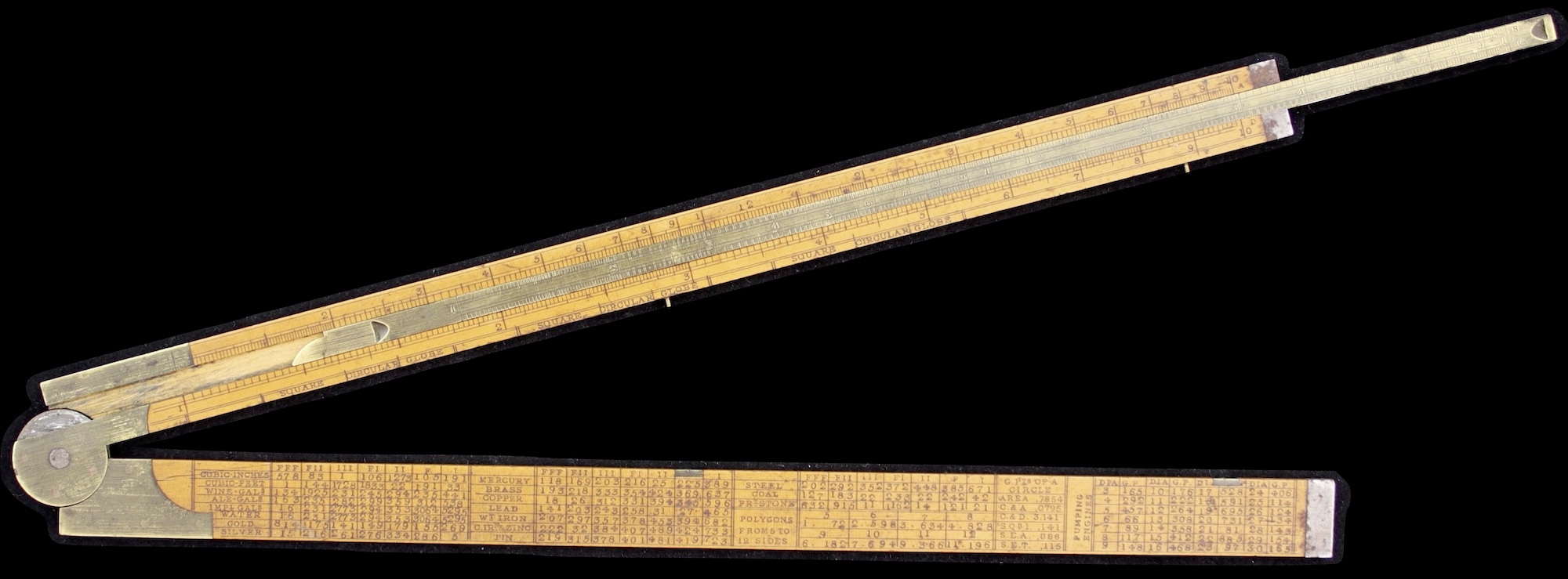
8.23.3 The Kutz Ullaging Rule
Very recently another old rule has suddenly come into my possession. This rule was first acquired several years ago by collector Tom Dilatush (1952-2024). After receipt of the item,98 I did some investigation into the maker of this slide rule — another New York instrument maker — Erasmus Kutz.

I found through the Webster Signature Database, maintained by the Adler Planetarium in Chicago, that Erasmus Kutz started his instrument company in New York in 1818 and that he primarily was a rule maker. His address changed several times, and at the time that the slide rule in my possession was created he was at 164 Water Street, which he occupied from 1824-1827.
As this particular slide rule was made just a few years later than the start of Belcher’s business, this makes it one of the earliest slide rules manufactured in America, as documented by the slide rule community. And if Erasmus made a few others near the start of his business, say when his business resided at 343 Water St., then there could be slide rules out there that are earlier than Belcher’s first American slide rules.
The Tom Dilatush web site, where you can see the slide rules he collected, is currently maintained by the International Slide Rule Museum, and Tom wrote about the story of the Kutz rule’s discovery, which is worthy of a look..
Our slide rule is a 24-inch-long gauging or ullaging rule. The Ly and St scales on the front bottom of the rule are for calculating the percentage of volume for the liquid within, used for measurements taken when the cask is either Lying on its side or Standing upright. The scales on the other side are mostly standard inch rulers, used for taking measurements of the cask or the depth of the liquid inside. It also has standard logarithmic scales for general multiplication and division computations, and other log scales for easily computing cask volumes. And the scales on the rule’s edge are for factoring in different shapes of barrels. For more information on gauging and gauging scales and calculations, see this vignette.
All of this brings me to why this rule is even more important to me at the moment. Besides being a very early American-made slide rule, this Kutz rule is the only US-made gauging rule I have seen. There are plenty of Carpenter’s and Engineer’s slide rules out there that were made in Early America, as well as Gunter’s scales (which do not “slide” but do have logarithmic scales), but I have yet to see another American gauging/ullaging rule. Of course just because I haven’t been able to find one on the various Collector’s and Oughtred Society’s sites doesn’t mean that they don’t exist. I cannot imagine that the Kutz is the only one. So, have others out there found examples of early American gauging/ullaging rules, or with relevant information? Please drop me a note.
As discussed in a previous vignette, the prevalent slide rules being produced in the early 1800s, other than occasional specialty items, were Gauging rules, Carpenter’s rules, Engineer’s rules, as well as the standard Gunter scale. Philip Stanley’s book on The Stanley Rule Company shows that Stanley had Gauging rods and Wanting (Ullaging) rods listed in its catalogs of the 1850s. But these were rules with scales that gave gallons of liquid by direct measurement, and did not involve any sliding parts. We now have verification that a U.S. instrument maker was making gauging slide rules in the 1820s, and perhaps a couple of years earlier. But while Kutz was an individual maker, both Belcher in the mid-1820s and Stanely in the late 1850s created manufacturing facilities for their rules, including slide rules.
Prior to about 1850 most of the early slide rules being manufactured were in the UK. France had begun to manufacture Soho rules in the early 1800s, and Mannheim’s slide rule concept was presented in 1850-51, with mass production started by Tavernier-Gravet in the late 1860s. The major German slide rule maker Dennert & Pape did not begin slide rule production until the early 1870s. With these time scales in mind, it should be no surprise that the earliest manufacturers of slide rules in the U.S. might be a family from England, already skilled in the rule-making business, who immigrated in the early 1800s.
The 1820s Kutz gauging slide rule and the c.1835 Belcher Brothers Engineer’s Rule in the collection have special places in the interesting history of the initial development of American-made slide rules.
The earliest American-made slide rules presently collected:
| Year | Maker | Model | |
|---|---|---|---|
| 1824-1827 | Kutz | Ullaging Rule |

|
| 1831-1843 | Belcher Bros. | Engineer’s Rule |

|
| 1843 | Palmer | Palmer’s Computing Scale |
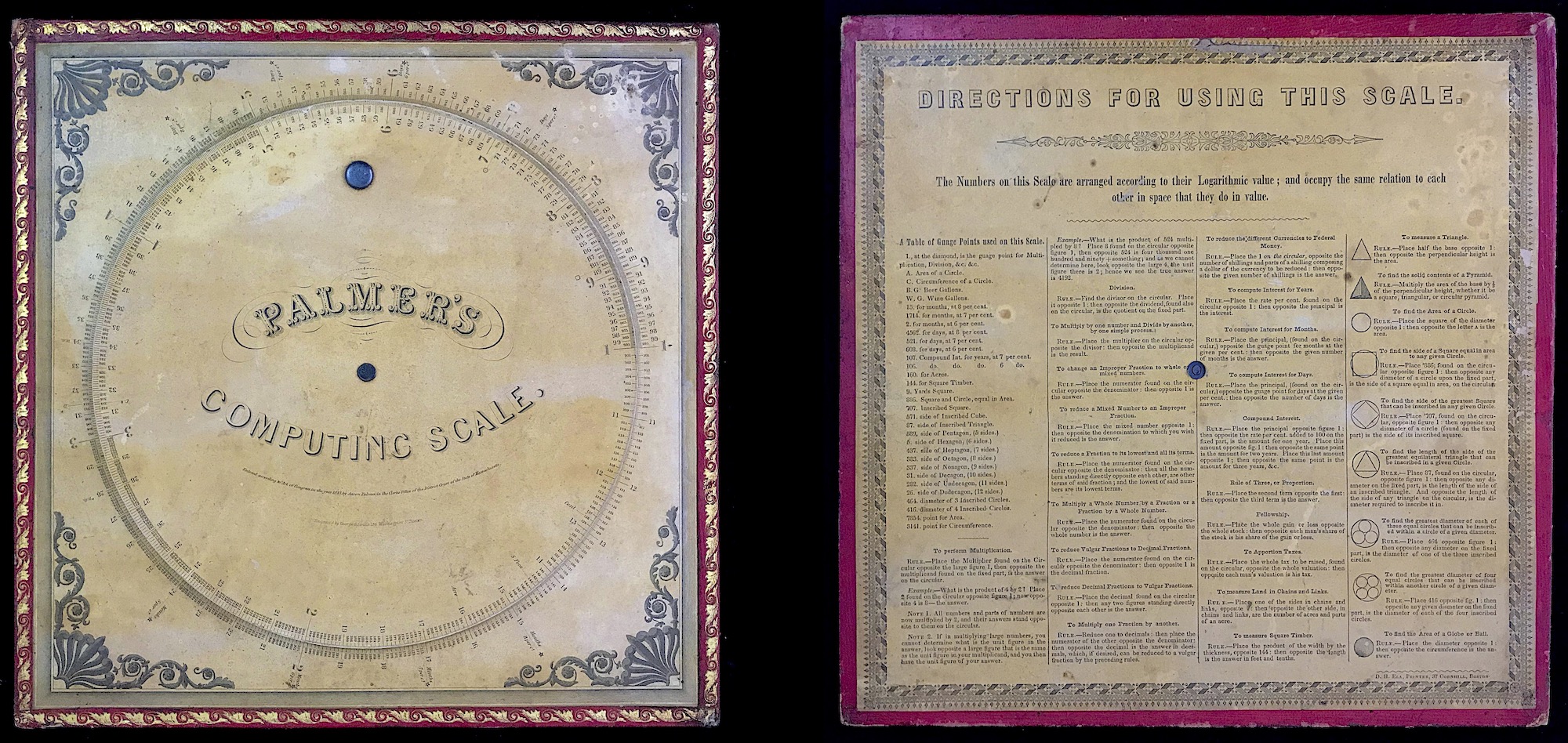
|
| 1845 | Palmer | Palmer’s Pocket Scale |

|
| c.1858 | Stanley | No. 15 |
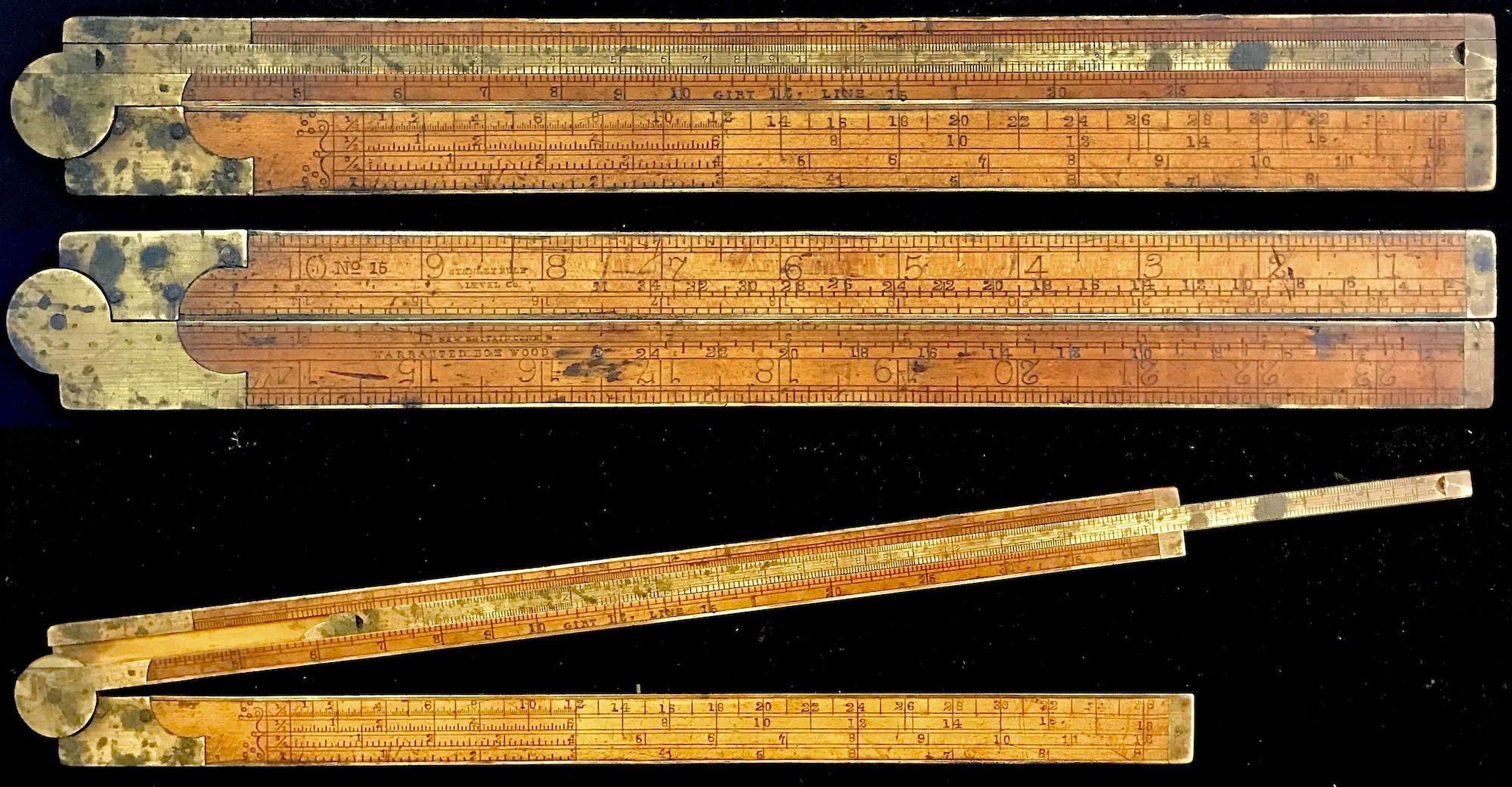
|
| 1901 | Scofield | Engineer’s Slide Rule |

|
| 1902-1912 | Dietzgen | 1765 |
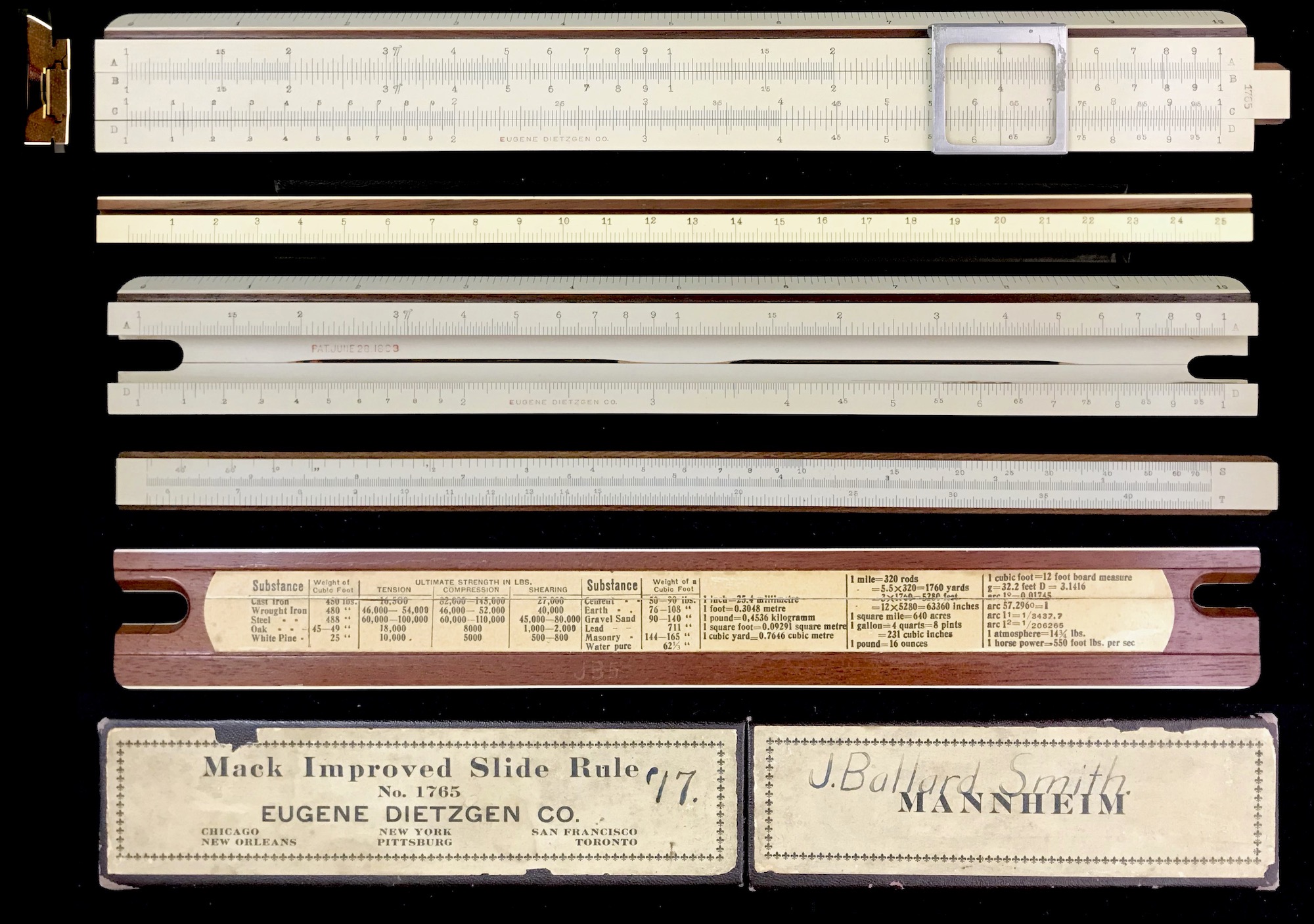
|
| 1903 | K&E | 4054 |
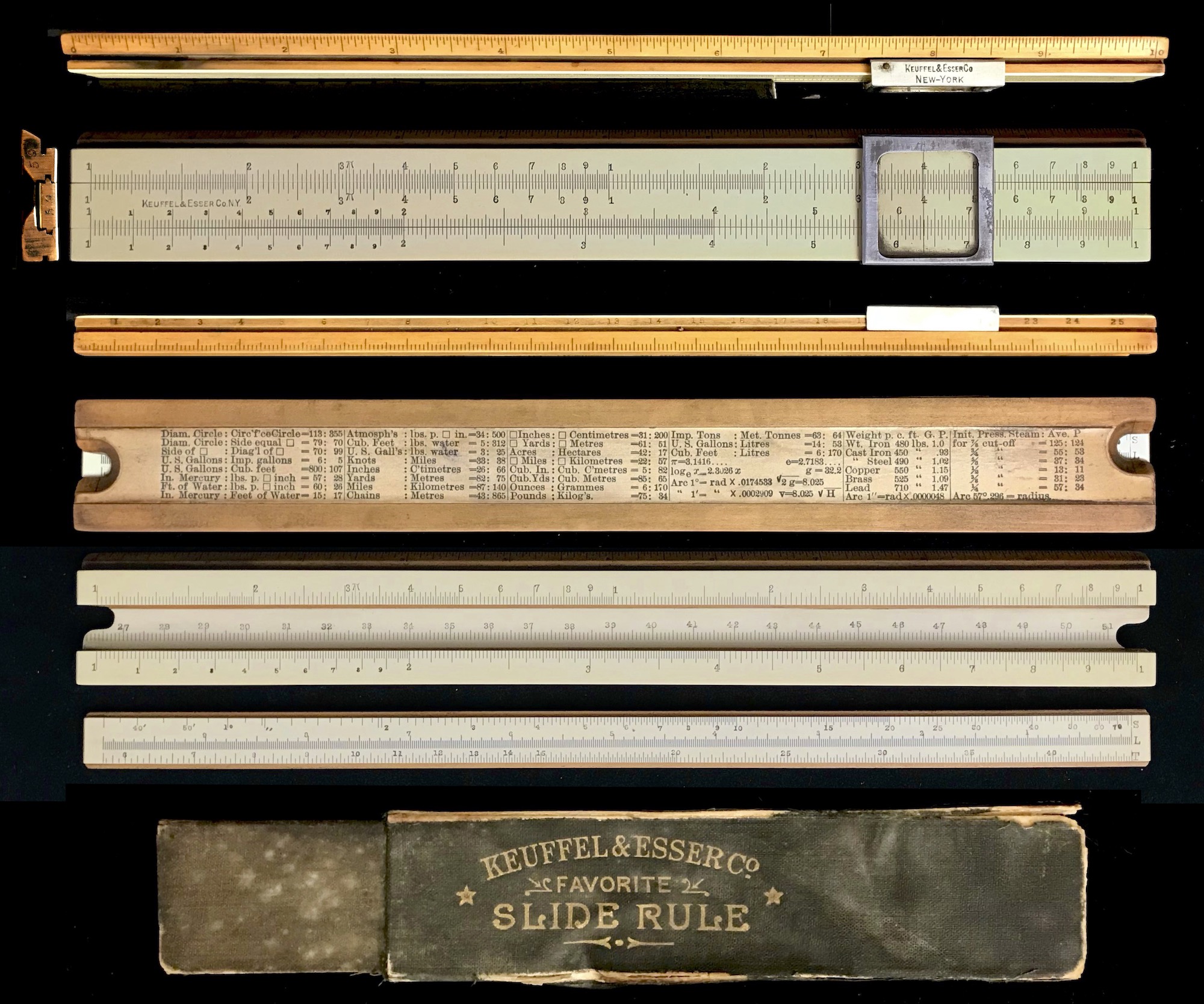
|
| 1904 | K&E | 4041 |
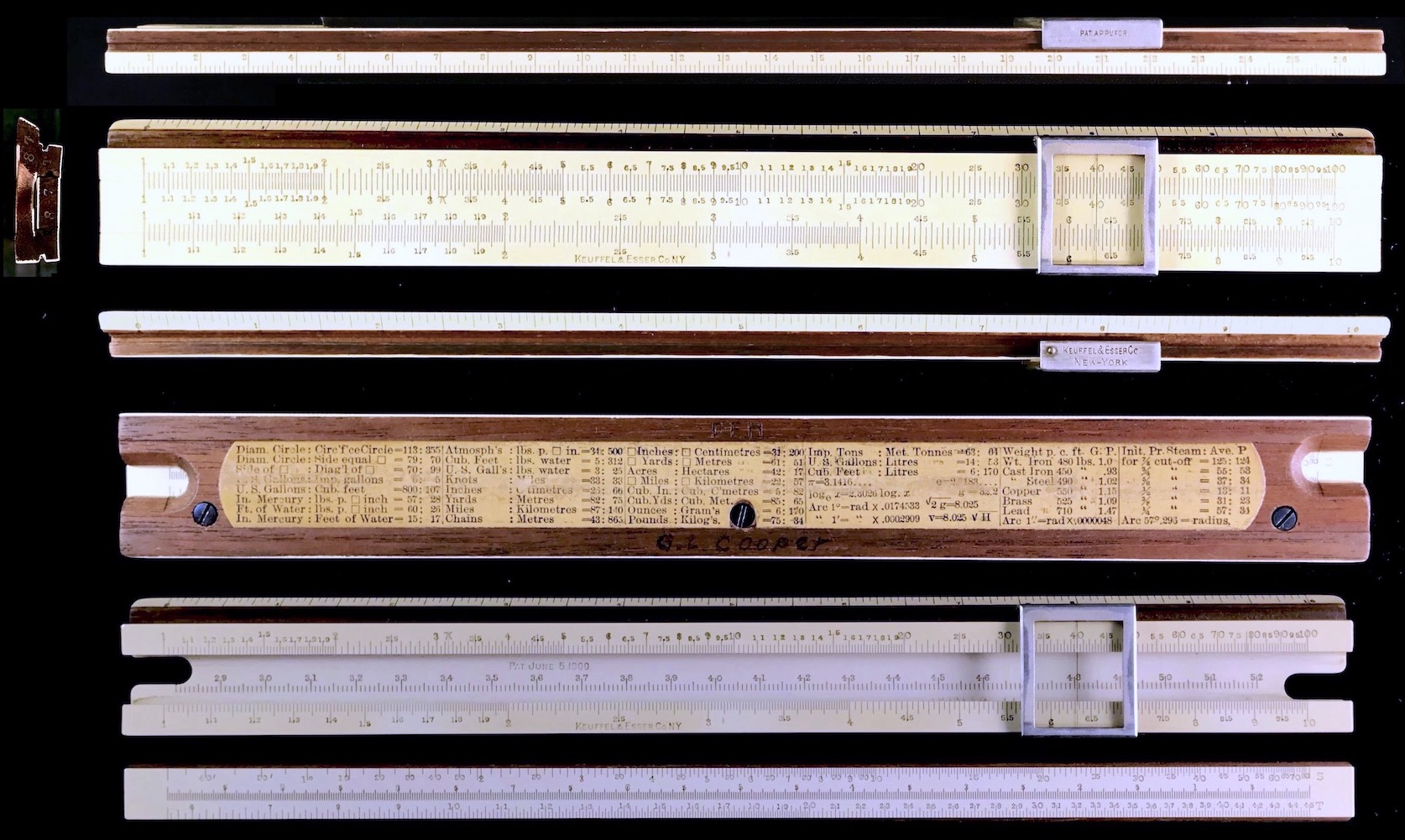
|
| c.1905 | K&E | 4035 |
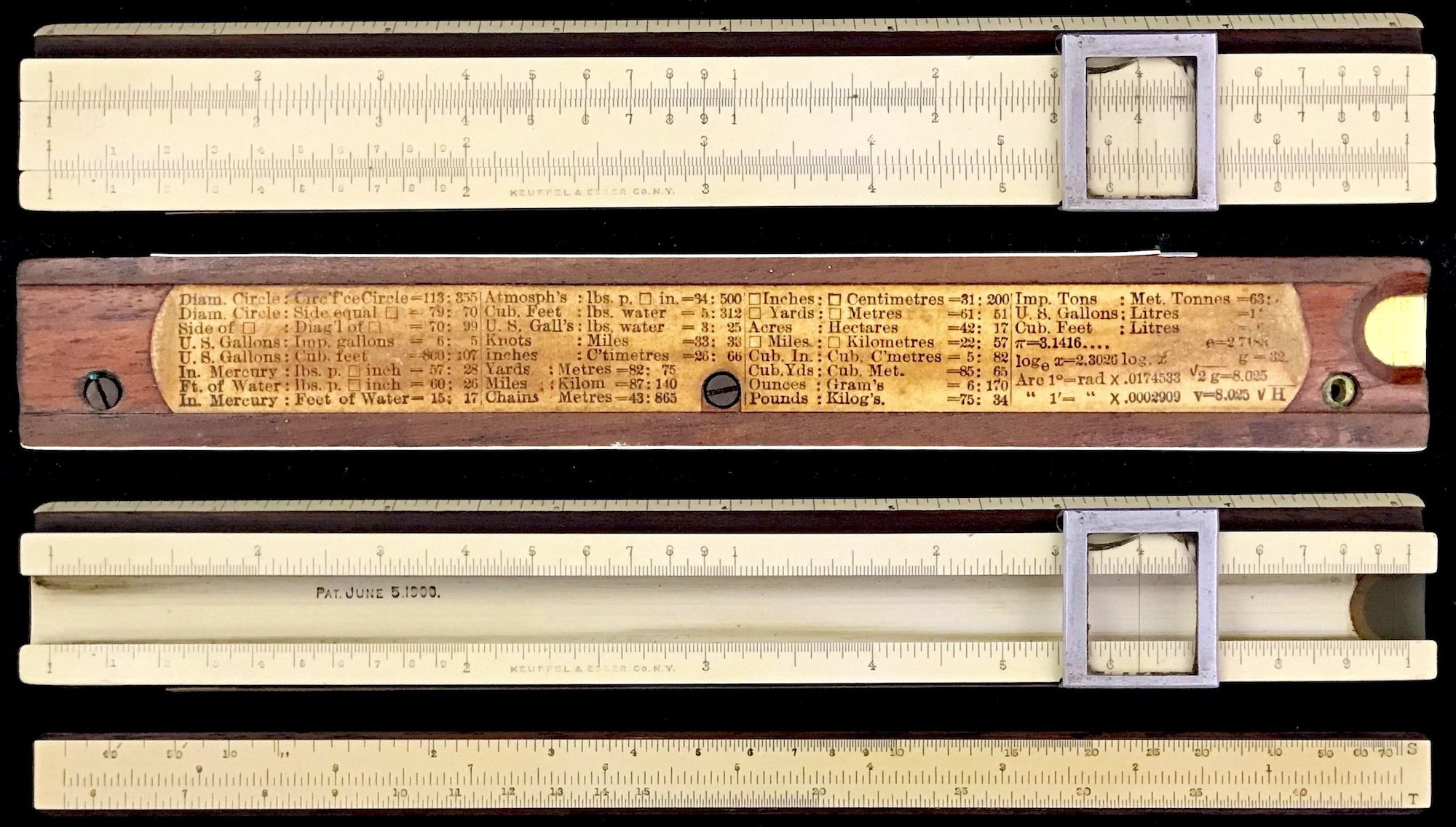
|
| c.1905 | K&E | 4041 |

|
Florian Cajori, A History of the Logarithmic Slide Rule and Allied Instruments, The Engineering News Publishing Company, New York, 1909.↩︎
Florian Cajori, “Aaron Palmer’s Computing Scale”, Colorado College, Colorado Springs, June 1909.↩︎
Thomas Wyman, “When Was The First Slide Rule Produced In The United States?”, Jour. Oughtred Soc., 23.1 p38 (2014).”↩︎
My Ruling Family- The Belcher Brothers & Cos., by Charles Zachary Belcher, Google Books (2013).↩︎
See the web page of antique tool collector Philip A. Cannon II, https://pactu.com/seven0610.2041/2f2fgb.htm.↩︎
Special thanks to the ISRM for help in acquiring this item.↩︎